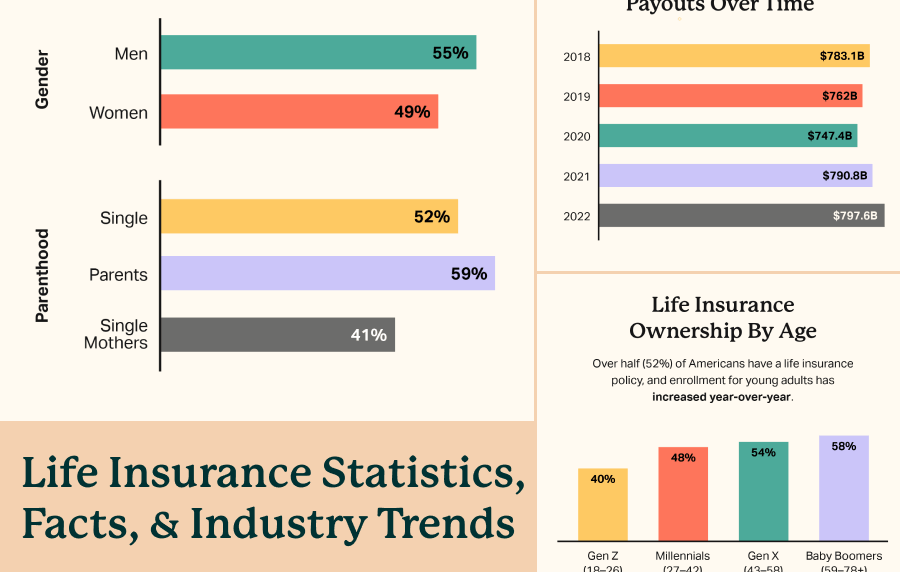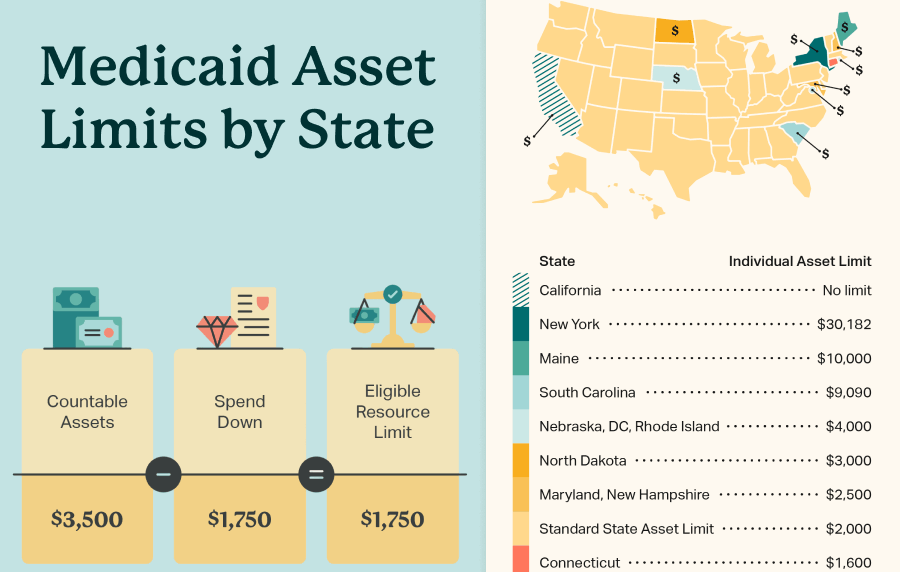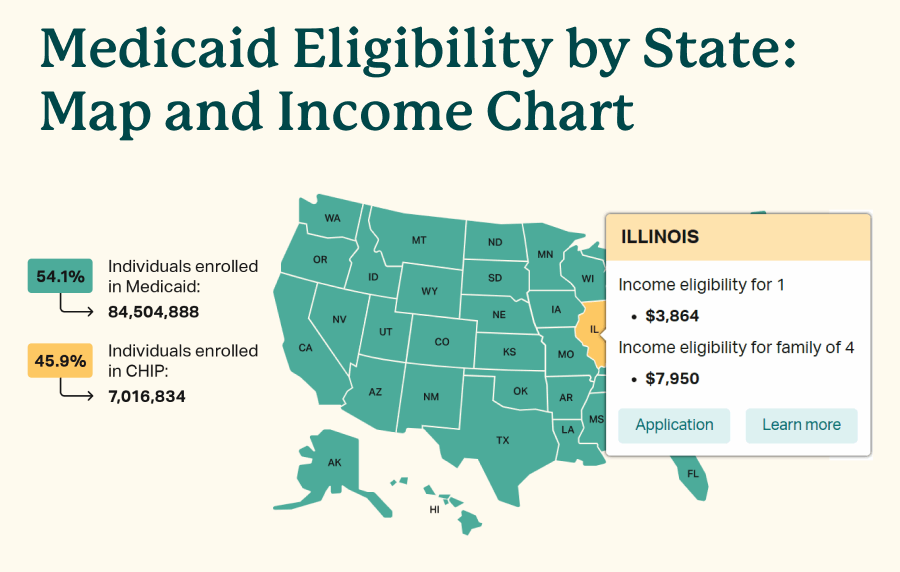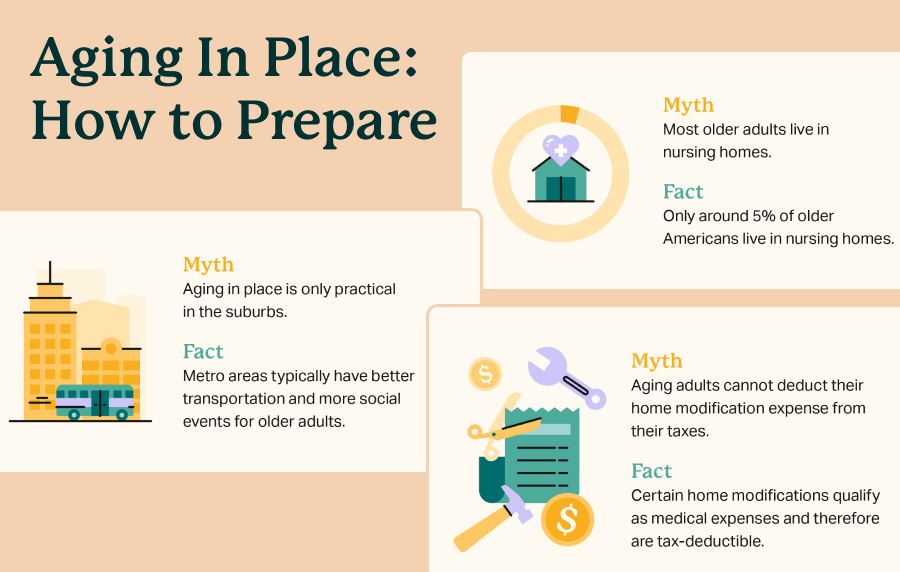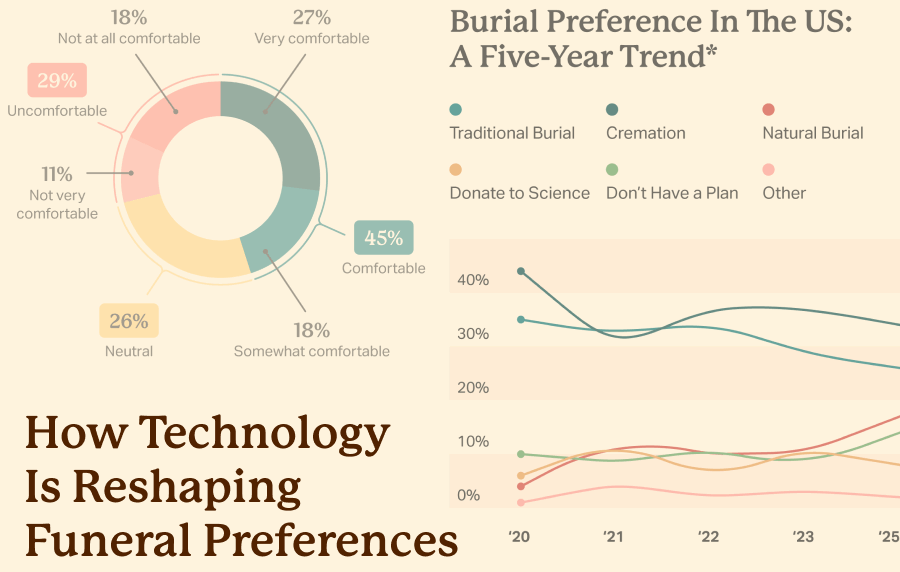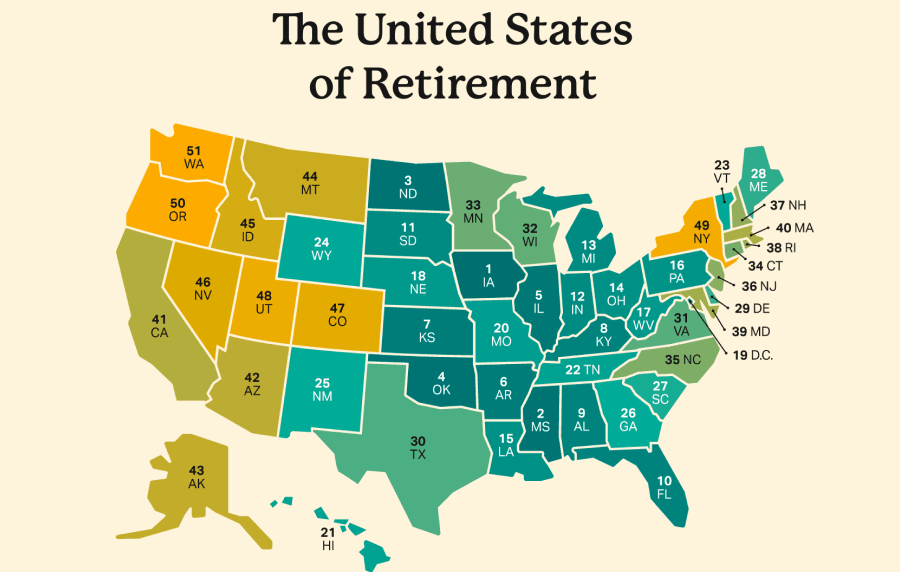We surveyed over 1500 people to take a pulse, so to speak, on burial traditions today. In the past, the most common thing to do with a body after death in the United States was a traditional burial, that is, a casket laid in the ground in a cemetery.
This choice was followed by cremation — and the number of traditional burials heavily outweighed cremations. In 1960, for instance, only 4% of Americans were cremated, while almost all the rest were buried traditionally. But times have changed.
Burial practices have shifted significantly since the 1960s, and they only continue to evolve. Here is how America wants to be buried in 2020.
The current state of burial preferences across our nation
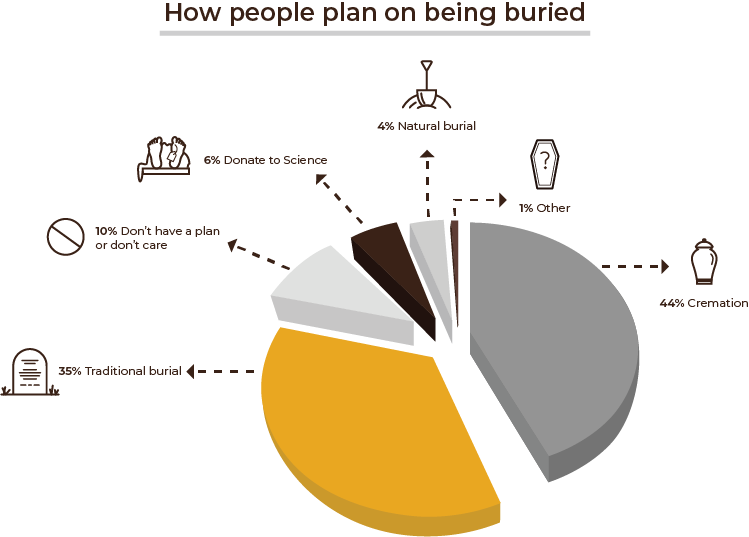
Traditional burial is no longer the norm. The majority of Americans (44%) plan on being cremated, while only about a third (35%) plan on the traditional method — a big transition from the small 4% of the people who preferred cremation in the ’60s.
And that still leaves 21% of Americans who plan to donate their body to science, be buried naturally (without a casket, directly in the ground), don’t have current burial plans at all, or are opting in for other unique arrangements, such as plastination, being launched into space, or a Viking send-off.
What Those Who Are Cremated Plan To Do With Their Ashes
While cremation is the most common way to dispose of a body after death in 2020, it’s what people do with the ashes that has significantly changed over the years. With the development of new tools and technologies, you have the option to get creative!
The 14% of respondents that chose to do something more creative with their ashes are wanting to have them:
- Painted or printed onto a canvas
- Turned into a coral reef
- Compressed into a diamond
- Turned into a glass creation
- Kept in a mausoleum
- Mixed with ink and used for a tattoo
- Pressed into a vinyl record
- Used in a firework
- Launched into space
What Influences Our Burial Plans
What are the reasons behind burial plans — why do some people choose cremation while others decided on donating their body to science? Almost half of the people (47%) made their burial plans based on personal beliefs and a fourth (24%) made their decision based on a family tradition. The remaining respondents decided on their burial plans for financial, religious, or other reasons, such as wanting their family to decide.
But what if those factors didn’t matter when choosing a burial option? Would people take a different route? According to our survey, nearly a third of people would — 30% of respondents chose a different plan when not taking into account family traditions, religious beliefs, and finances.
Items We Want To Take With Us
Sometimes, you can take it with you. While 21% of people don’t care about being buried with their possessions, the majority said they want to take a few personal items along.
Half of Americans want to be buried with photos of loved ones — 60% of these people were millennial’s (ages 18–34), while only 40% were over the age of 45. About one in five (that’s 20%!) of our respondents said they wanted to be buried with the remains of a pet or loved one.
Some want to be buried with family heirlooms, sports memorabilia, or other personal items, like Chuck Norris T-Shirts, their favorite perfume, or even “copious quantities of cannabis.”
Alternative Burial Methods & How Much They Cost
If you’re looking for something that’s out of the ordinary, there are plenty of alternative burial methods to choose from. While some of these methods are newer and only offered by a limited number of companies, others resemble ancient burial traditions. Let’s take a closer look at what they are.
Burial Methods Available In The United States
Although cremation and casket burials are still the most common in the United States, they aren’t the only options. Apart from the cost of traditional burial and cremation, each of these alternative methods includes only the cost of body preparation and not the cost of viewing and memorial services.
Traditional burial — $7,360 on average
For a full traditional burial and memorial services, including embalming and body preparation, a hearse, casket, and all other service fees, it’ll cost you about $7,000 — and that’s without a burial plot or headstone. In total, everything from the services to the headstone could cost you $9,000 or more. Consider a burial insurance policy if you cannot afford to pay these expenses out of pocket.
Cremation — $6,260 on average
Instead of putting the body into a casket and burying it in the ground, the body is incinerated and turned into ash. There’s no need to purchase a casket, just an urn in which to keep the ashes. If you’re only planning on direct cremation (no viewing or memorial services), it could cost as little as $500. But if you want to hold a funeral service, it’ll cost you thousands of dollars more.
Mummification — Starts at $67,000
You don’t have to be Egyptian royalty to be mummified these days — but you’ll need the bank account of a royal to afford it. Mummification is a lengthy process that takes 70 days, and there’s only one place in the world (it’s in Salt Lake City, Utah) that will do it for you. Just keep in mind that $67,000 will only cover the mummification process. So if you want a sarcophagus where you can lay to rest, you’ll need another $20,000-$100,000.
Natural burial — Starts at $3,500
A natural burial is the most simple and eco-friendly burial process. Instead of being embalmed and put into a casket, the body is placed directly into the ground, where it can naturally decompose. While this method may save you money on the body preparation costs and the casket, you’ll end up paying more for the designated natural burial plot than a traditional plot.
Cryonics — Starts at $28,000
Cryonics is the opposite of cremation. Instead of being burned, the body is frozen to a temperature low enough that it won’t decompose. While you won’t be alive, your body will be perfectly preserved. And who knows — maybe scientists will be able to revive you in the year 3000.
Alkaline hydrolysis — Starts at $1,400
An environmentally friendly substitute for cremation, alkaline hydrolysis, uses water to break down the body. And similar to cremation, there are powdered remains that can be kept in an urn or scattered somewhere. While it’s legal in the United States, the catch is that some states have regulations concerning alkaline hydrolysis. There are many other names for this process, such as aquamation, flameless cremation, bio-cremation, green cremation, and water cremation.
Plastination — Starts at $40,000
If you’ve ever experienced a Body Worlds exhibit, then you know what a plastinated body looks like. Plastination uses a lengthy, one-year process that removes all of the fluids from the body and replaces it with a polymer or plastic-like substance. Although it’s an expensive process, plastination won’t cost you a dime — currently, the only way to do it is by donating your body to a company that specializes in body plastination. Such companies often use plastinated bodies as study subjects and for instructional purposes.
Sea burial — Starts at $5,000
Different than spreading ashes over the ocean, a sea burial involves putting the body in a casket and sinking it in the water. But it’s not as simple as it sounds — there are many regulations for sea burials. It requires a special casket with holes in it that weighs enough for the body to sink to the bottom of the ocean, and you’ll need to rent a boat that will take you at least three nautical miles from shore.
Donate to science — Free
If you’re looking for the most affordable option, donating to science is free. Depending on the circumstances and the organization to which you decide to donate, you might even get the cost of cremation covered, so your family will still get to keep the ashes. Most organizations won’t just accept anybody, though. You need to register as a donor and find out if your body will be accepted as a donation beforehand.
Creative Uses Of Cremains
We looked into various companies that offer unique services and found the lowest rate for the basics of each use of cremains. These prices can be higher depending on the company you use and if you choose a more elaborate service package. The options below do not include the cost of the actual cremation.
Memorial diamond — Starts at $2,200
You can have your ashes compressed into a diamond and used in jewelry. There are even options to customize the color and the cut.
Coral reef — Starts at $2,400
Your cremains can be mixed with a concrete-like substance and turned into an artificial coral reef. You’ll then be placed in the water to house marine life.
Cremains painting — Starts at $250
An artist will mix your ashes with paint and create a piece of art that represents you.
Cremains printed portrait — Starts at $127
Using new technology, you can choose an image and have it printed onto a canvas using your ashes.
Firework — Starts at $1,000
Have your cremains mixed with flammable and explosive substances and turned into a firework.
Vinyl record — Starts at $1,160
You can have your ashes pressed into a functional vinyl record. You’ll even get to decide what sound clips it plays.
Glass art — Starts at $180
Your ashes are mixed with glass and blown into a piece of unique glassware.
Planted as a tree — Starts at $50
Cremains are placed into what’s known as a “bio-urn” — a biodegradable urn that will help a tree grow with the use of your ashes.
Launch into space — Starts at $2,500
Also known as a “space burial,” you can have a portion of your ashes sent into space and dropped into the orbit of the Earth.
Commemorative tattoo — Starts at $289 for ink (not including labor)
Your ashes are mixed with tattoo ink using a unique process that sterilizes the ashes to remove any potentially harmful substances. This ink can then be taken to a tattoo artist and used in any design, just like any other regular tattoo ink.
Burial Alternatives Not Available In The United States
There are some alternative burial options, both ancient and new, that aren’t available in the United States for one reason or another.
Viking burial
Ancient Norse death rituals included placing a body into a small boat. The boat was then lit on fire and sent out to sea. This is illegal in the United States as each state has specific laws against the desecration of human remains, and burning a body (other than normal cremation) falls under those laws.
Sky burial
Also known as “exposure,” sky burials originated in ancient Asia, where a body is left out in the open, usually on top of a mountain, to naturally decompose and be eaten by birds and animals. Like Viking burials, sky burials are illegal because intentionally allowing animals to scavenge the remains of a body is considered desecration.
Promession
This is still a developing method and is said to cost much less than even basic cremation. It consists of freeze-drying a body, resulting in a powder that can be kept in an urn (similar to cremation or alkaline hydrolysis). Because it is still an experimental method, it’s currently not offered in most countries, including the United States.
What Will You Choose?
You’ve got plenty of options — whether you’d like to stick with a traditional burial or you want to do something out-of-the-box, and, whether you choose based on family tradition or just personal preference, it’s up to you to decide how you’ll leave a lasting impression at the end of your life. Regardless of your preference, takes steps now to prepare for the financial impact of your desires.
You can preplan with a funeral home, set money aside in a savings account, or get a life insurance policy (even seniors over 80 can get life insurance). Just do something so your family isn’t left with the bill.
Methodology
We surveyed 1,500 people in the United States about their burial plans and preferences. We asked them how they plan to be buried after they die, what influenced their burial plans, how they would choose to be buried if they weren’t influenced by factors outside of their own preferences and beliefs, and what items they’d like to be buried with.
Breakdown of respondents:
Age:
- 18–24 years: 12%
- 25–34 years: 22%
- 35–44 years: 20%
- 45–54 years: 16%
- 54+ years: 30%
Gender:
- Female: 57%
- Male: 43%
Refer to the 2024 survey results for the most up-to-date version of the annual funeral preferences survey.
- Nationally licensed life insurance agent with over 15 years of experience
- Personal annual production that puts him in the top .001% out of all life insurance agents in the nation.
Anthony Martin is a nationally licensed insurance expert with over 15 years of experience and has personally served over 10,000 clients with their life insurance needs. He frequently authors entrepreneurial and life insurance content for Forbes, Inc.com, Newsweek, Kiplinger, and Entreprenuer.com. Anthony has been consulted as an expert life insurance source for dozens of high-profile websites such as Forbes, Bankrate, Reuters, Fox Business, CNBC, Investopedia, Insurance.com, Yahoo Finance, and many more.
Choice Mutual often cites third-party websites to provide context and verification for specific claims made in our work. We only link to authoritative websites that provide accurate information. You can learn more about our editorial standards, which guide our mission of delivering factual and impartial content.
-
4% of Americans were cremated. https://news.usc.edu/143438/what-we-think-about-death-and-funerals-is-changing/
-
Salt Lake City, Utah. https://www.summum.us/
-
the body is frozen. https://www.cryonics.org/about-us/faqs/
-
regulations concerning alkaline hydrolysis. https://www.nolo.com/legal-encyclopedia/alkaline-hydrolysis-laws-your-state.html
-
lengthy, one-year process. https://bodyworlds.com/plastination/plastination-technique/
-
regulations for sea burials. https://www.epa.gov/ocean-dumping/burial-sea
-
ashes compressed into a diamond. https://www.heart-in-diamond.com/
-
artificial coral reef. https://www.us-funerals.com/underwater-memorial-reefs/
-
mix your ashes with paint. https://www.memorials.com/art-in-ashes.php
-
printed onto a canvas. https://www.cremationsolutions.com/other-cremation-options/cremation-portraits
-
turned into a firework. https://slate.com/culture/2019/05/memorial-fireworks-human-ashes-cremation-poms-movie.html
-
functional vinyl record. https://www.thevintagenews.com/2019/02/14/vinyl/
-
ashes are mixed with glass. https://artfulashes.com/
-
ashes sent into space. https://elysiumspace.com/
-
ashes are mixed with tattoo ink. https://engraveink.com/
-
each state has specific laws against the desecration of human remains. https://law.justia.com/codes/oklahoma/2014/title-21/section-21-1161.1






